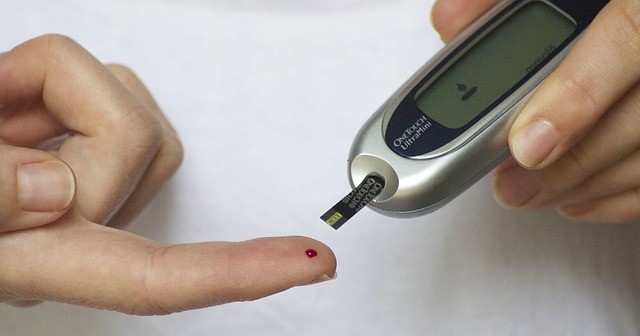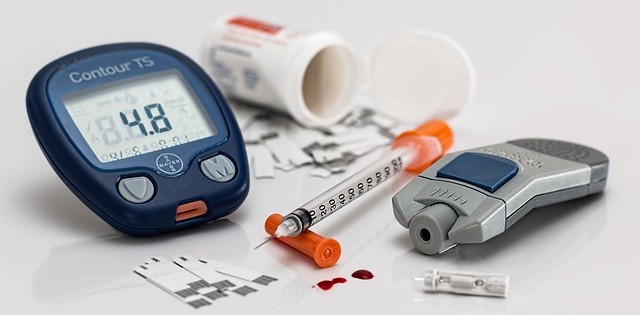Diabetes by the Numbers
Since 1980, the number of adults with diagnosed diabetes in the United States nearly quadrupled. The increase can be explained part to people with the disease living longer because of advances in management and care, but is also due to obesity and an increasingly sedentary lifestyle.

29.1 MILLION people have diabetes
Diabetes is a group of diseases marked by high levels of blood glucose resulting from problems in how insulin is produced, how insulin works, or both. There are several types of diabetes, the most common being Type 1, Type 2, and gestational diabetes.
-
Type 1 diabetes
- Type 1 diabetes, previously called insulin dependent or juvenile-onset diabetes, develops when the cells that produce the hormone insulin, known as the beta cells, in the pancreas are destroyed by the body’s immune system.
-
Type 2 diabetes
- Type 2 diabetes, previously called non–insulin dependent or adult-onset diabetes, usually begins with insulin resistance, where cells in muscles, liver, and fatty tissue do not use insulin properly. As the need for insulin rises, the beta cells in the pancreas gradually lose the ability to produce sufficient quantities of the hormone.
-
Gestational diabetes
- During the second or third trimester of pregnancy, increasing blood glucose levels can be dangerous for both the mother and the baby. Standard treatments, suchs as a healthy diet, regular physical activity, or insulin, can manage the risk. Gestational diabetes often disappears after birth, though the mother is at a higher risk of type 2 diabetes in the future.
Other types of diabetes are caused by specific genetic conditions or from surgery, medications, infections, pancreatic disease, or other illnesses. These types of diabetes account for a very small percent of all cases, about 1% to 5%.
Prediabetes
Another 86 million adults – more than one in three U.S. adults – have prediabetes, where their blood sugar levels are higher than normal but not high enough to be classified as type 2 diabetes. Without weight loss and moderate physical activity, 15 percent to 30 percent of people with prediabetes will develop type 2 diabetes within five years.
Among adults, about 1.7 million new cases of diabetes are diagnosed each year. If this trend continues, as many as 1 out of every 3 adults in the United States could have diabetes by 2050.
7th leading cause of death in the US
Diabetes was listed as the cause of death for 75,578 people in 2013, according to the Center for Disease Control’s National Vital Statistics Report, making it the 7th leading cause of death in the United States.
Diabetes may be underreported as a cause of death. People with diabetes may have or develop other complications or conditions, including high blood pressure, heart disease, and kidney disease. Studies have found that only about 35% to 40% of people with diabetes who died had diabetes listed anywhere on the death certificate and about 10% to 15% had it listed as the underlying cause of death.
Worldwide, total deaths from diabetes are projected to rise by more than 50% in the next 10 years. Most notably, they are projected to increase by over 80% in upper-middle income countries.
$245 BILLION estimated annual cost of diabetes in the United States
Diabetes, its complications and subsequent care accounts for 10-20% of health care spending in the US. According to the American Diabetes Association’s Professional Resources, the total estimated costs of diagnosed diabetes in 2012 is $245 billion, a 41% increase from $174 billion in 2007. This figure includes direct (hospital and emergency care, office visits, and medications) and indirect (absenteeism, reduced productivity, unemployment disability and early mortality) medical costs, totaling $176 billion and $69 billion, respectively.
Additionally, medical expenditures for people with diabetes are 2.3 times higher than for those without diabetes.
ONE THIRD of all people with diabetes do not know they have the disease.
That’s about 8.1 million people! Type 2 diabetes often does not have any symptoms, or the symptoms can be so mild you don’t notice them.
Symptoms include:
- Hunger and fatigue. Your body converts the food you eat into glucose that your cells use for energy. But your cells need insulin to bring the glucose in. If your body doesn’t make enough or any insulin, or if your cells resist the insulin your body makes, the glucose can’t get into them and you have no energy. This can make you more hungry and tired than usual.
- Peeing more often and being thirstier. Normally your body reabsorbs glucose as it passes through your kidneys. But when diabetes pushes your blood sugar up, your body will try to get rid of the extra. You’ll have to go more often, and probably pee out more, too. Because you’re peeing so much, you can get very thirsty. When you drink more, you’ll also pee more. It’s a vicious cycle.
- Dry mouth and itchy skin. Because your body is using fluids to make pee, there’s less moisture for other things. You could get dehydrated, and your mouth may feel dry. Dry skin can make you itchy.
- Blurred vision. Changing fluid levels in your body could make the lenses in your eyes swell up. They change shape and lose their ability to focus.
9 to 1, the ratio of type 2 diabetes to all other forms combined
About 75 million Americans either have type 2 diabetes or are on their way to developing it. Your risk increases as you get older (over 45 years old), if you are overweight or obese, or if you if you carry most of your weight around your abdomen.
Are you at risk for type 2 diabetes?
There are some diabetes risks factors that you cannot control, such as age, genes and ethnicty (African Americans, Hispanic Americans, Asian Americans, Native Americans and Pacific Islanders are all at an increased risk for type 2 diabetes). Your medical history is also relevant. For example, if:
- You’ve already been told you have pre-diabetes,
- You had gestational diabetes or a baby who weighed more than nine pounds,
- You have high blood pressure,
- Your triglyceride level is above 250 mg/dl or your HDL is below 35 mg/dl, or
- You are a woman who has Polycystic Ovary Syndrome (PCOS)
You are at an increased risk for type 2 diabetes. But there’s nothing you can do about the past.
Focus on what you can control – certain lifestyle factors like smoking, stress, lack of exercise and sleeping too little or too much can also increase your risk of developing type 2 diabetes.
The more risk factors you have, the higher your chance of developing type 2 diabetes. But people with a high risk of developing (or that are already diagnosed with) diabetes can take steps to manage their risk of health problems by healthy eating, regular physical activity, and medications to lower blood glucose levels. In fact, as little as 30 minutes of moderate physical activity each day can moderate your risk for type 2 diabetes.

Take Control of Your Health
When managing your diabetes, you’re constantly making decisions about treating blood glucose, exercise and healthy eating. Making those decisions is much easier if you keep track of that data, but tracking that data can be overwhelming.
Activ Doctors Online’s personal health record makes it easier to organize and track your health information online, including:
- Blood glucose
- A1C
- Blood Pressure
- Cholesterol
- Physical activity
- Weight
- Medications
And, you can share valuable health information with your doctors, which can lead to improved outcomes. Get started today >>